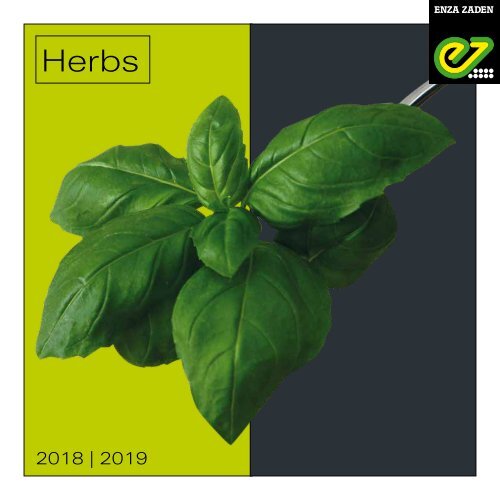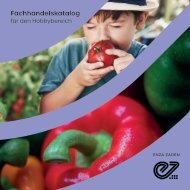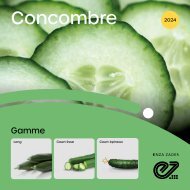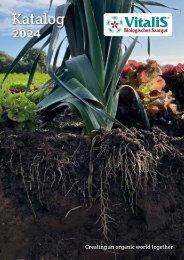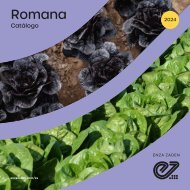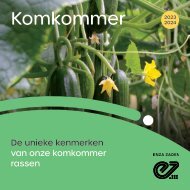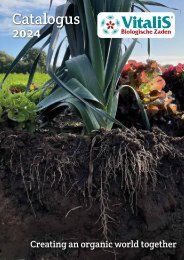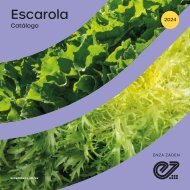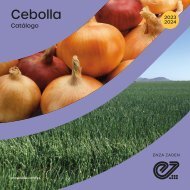Brochure Herbs 2018 | 2019
- No tags were found...
Create successful ePaper yourself
Turn your PDF publications into a flip-book with our unique Google optimized e-Paper software.
<strong>Herbs</strong><br />
<strong>2018</strong> | <strong>2019</strong>
New generation and<br />
well-known herb varieties<br />
Enza Zaden has been selling herbs since 2001. Our main markets are Europe and the<br />
United States, with a particular focus on Scandinavia, the Baltic States, UK, Benelux,<br />
Germany, France, Italy, Canada and Eastern Europe. Within these markets, our crop<br />
focus is on basil, chive, dill, parsley and wild rocket (Rucola selvatica/Diplotaxis<br />
tenuifolia).<br />
We are constantly working to improve our existing varieties. By developing disease<br />
resistance in our herbs, we make sure our customers get the best crops and<br />
seed quality. We also test our varieties for shelf life to supply our customers with<br />
products for both local and export markets. All herbs are tested for NFT (nutrient film<br />
technique) suitability and especially in Scandinavia we have gained a high level of<br />
expertise over the past years. We have made significant investments to ensure our<br />
growers the best seeds possible.<br />
This brochure gives you an overview of our herb portfolio. Learn more about our<br />
new generation of basil, parsley and rucola varieties with excellent quality traits like<br />
resistance, shelf life or cold tolerance. Our RMTD label indicates those varieties in<br />
the brochure so you can identify them at a glance. Moreover, you can also find our<br />
other herb types and well-known varieties in this brochure.<br />
Our specialized team at Enza Zaden Germany is at your service to provide additional<br />
information and advice on the cultivation of herbs. You can also contact your local<br />
contact person for more information.<br />
Enza Zaden | 3
Resistance Makes The Difference<br />
Basil<br />
(Ocimum basilicum, Lamiaceae)<br />
Resistance Makes The Difference<br />
New generation herb varieties<br />
To attune our newest herb and rucola varieties to the wishes and demands<br />
of the market, the Enza Zaden breeders are always in close contact with<br />
our growers and other parties in the chain. This co-operation has lead to<br />
a new generation of herb varieties. A generation that covers new ideas and<br />
offers unique solutions to our customers.<br />
Emma | new (E09B.9017)<br />
Our new Genovese type variety with an intermediate<br />
resistance against Downey Mildew. Recommended for pot<br />
and NFT production.<br />
The focus of the breeding activities for this new generation was:<br />
• DM resistance in basil.<br />
• Fusarium resistance in basil.<br />
• Shelf-life and cold tolerance of basil.<br />
• DM resistance in parsley.<br />
• DM and Fusarium resistance in rucola.<br />
• Extended shelf-life in rucola.<br />
On top of that we started more and more to select on easy picking and fast harvesting selections.<br />
Keira<br />
New Genovese type, suitable for pot production and also for<br />
fresh market. Medium sized, dark green leaves. Excellent<br />
shelf-life. Cold tolerant, perfect for long shipments.<br />
Now we can proudly present the outcome of this thriving program:<br />
• 4 basil varieties: Eleonora, Elidia, Keira and Emma.<br />
• 2 parsley varieties: Peione and Orfeo.<br />
• 5 rucola varieties: Prudenzia F1, Jolizia, Bellezia, Anastazia and Letizia.<br />
All of them are already well tested at professional growers and controlled by official trial stations and<br />
universities. Their characteristics are unique and outstanding.<br />
On the following pages of this brochure you will find more information about these new generation<br />
of herb varieties and their characteristics. The quality mark indicates which varieties<br />
belong to this new generation.<br />
Please contact your local Enza Zaden dealer for receiving more information and advice.<br />
Elidia<br />
Genoveser type with intermediate resistance<br />
against Fusarium. Compact growth. Ideal for pot<br />
production. Shiny dark green leaves. Late bolting.<br />
4 | Enza Zaden<br />
Enza Zaden | 5
Resistance Makes The Difference<br />
Resistance Makes The Difference<br />
Parsley<br />
(Petroselinum crispum)<br />
Rocket Wild<br />
(Rucola selvatica, Diplotaxis, Brassicaceae)<br />
Peione<br />
Perfect new Gigante d’Italia type with high homogeneity,<br />
dark green colour and bigger leaves than the standard.<br />
Heavy yield. Both for fresh market and processing.<br />
Intermediate resistance to Downey Mildew.<br />
Jolizia | new (E09B.9017)<br />
Our new summer variety. Very good serration in the first<br />
cut and an excellent shelf life. Slow in bolting and with an<br />
intermediate resistance against Downey Mildew.<br />
Prudenzia F1<br />
Fast growth, intermediate resistance against Downey Mildew.<br />
Perfect for growing in spring and autumn. Very fine serration<br />
and fresh green colour for highest quality. Upright growth for<br />
healthy leaves and efficient harvest. Very good shelf-life.<br />
Orfeo<br />
New Paramount selection. Very homogen with<br />
dark green, strong curled leaves. High dry matter.<br />
Perfect for export and for longer storage.<br />
Anastazia<br />
For growing in (early) summer. Stable leaves with<br />
3D optic and dark green colour, also after harvesting.<br />
Intermediate resistance against Downey Mildew.<br />
Upright and compact growth for an easy harvest.<br />
Good shelf-life.<br />
6 | Enza Zaden<br />
Enza Zaden | 7
Basil (Ocimum basilicum, Lamiaceae)<br />
Variety Cultivation Description<br />
Annual, height 20-40 cm<br />
Emma | new<br />
(E09B.9017)<br />
Edwina<br />
Eowyn<br />
Fresh<br />
cut<br />
Processing<br />
Pot<br />
plant<br />
Elidia x x<br />
x<br />
x<br />
x<br />
NFT<br />
Our new pot basil with a dark Genovese leaf and an intermediate resistance<br />
against Downey Mildew.<br />
Reliable variety in the Genovese type for a year round pot production. Also<br />
under low light conditions this variety produces shiny dark green leaves and a<br />
very uniform plant horizon in the pots.<br />
Very strong and compact basil variety in the Genovese type for pot cultivation.<br />
The brilliant dark green colour and the compact plant type makes Eowyn unique.<br />
Improved shelf life.<br />
Genovese type with intermediate resistance against Fusarium. Compact growth,<br />
ideal for pot production.<br />
Marian x x Compact pot basil very stable and errect tolerant against Downey Mildew.<br />
Emily x x x x<br />
Very compact pot basil variety. Genovese type with medium large leaves. Emily<br />
is recommended for summer production in more balanced climates, all year<br />
round in hot climates or production under high light intensity. The elongated<br />
shelf life of Emily enables an extended transport phase. Very suitable for artifical<br />
lights.<br />
Tsw:<br />
1,1-1,7 g | Seed count per 10 g = 6.000-9.000 seeds.<br />
Sowing: From mid May outdoor or under protected cultivation the whole year round.<br />
Light germinator, tender.<br />
Seed amount: Direct sowing 50 g/100 m², in seedbed 3 g/1.000 plants, pot growing<br />
20 g/1.000 pots.<br />
Cultivation: Spacing for pots 20-25x25 cm; outdoor growing in rows 20 cm apart and<br />
30-40 cm between the rows.<br />
Basil is quite tender and susceptible to smothering through weeds.<br />
To ensure a good harvest therefore it is recommended to use plastic sheeting<br />
as a mulch. Also Acryl-webbing for cold protection is advisable. Planting out<br />
young plants is an advantage and gives a better start to the crop.<br />
Harvesting: For the fresh market cut the young shoots into bundles.<br />
For industrial use the first cut should be done when flowering begins.<br />
The cut should not be too low (ca. 10 cm) to encourage a second growth.<br />
Basil is very sensitive to pressure and should be carefully dried at a<br />
temperature of 40°C immediately after harvest.<br />
Use:<br />
In salads, soups, vegetables, meat and tomato dishes and also raw.<br />
Rosie<br />
Keira x x x x<br />
Dolly x x (x) (x)<br />
Eleonora x x (x)<br />
Genoveser x x<br />
New Marian type for pot production and processing with excellent shelf life.<br />
Cold tolerant.<br />
Very uniform, large leaved and fast growing variety with improved tolerance<br />
against low temperatures. Recommended for open field production.<br />
Basil with intermediate resistance against Downey Mildew. Big, light serrated<br />
leaves. For open field and pot production.<br />
Shiny, dark green, spoon shaped leaves. High yielding. Special Genovese<br />
selection for industry.<br />
Lemon sel.<br />
Lemona<br />
x x Fine leaved, quick growing, with a definite lemon flavour.<br />
Piccolino x (x)<br />
Rosie x x x<br />
Very compact growing basil with a strong aroma, ideal for pot growing and<br />
original pesto.<br />
Red variety with intense dark red colour. Compact and upright<br />
growth on robust stems.<br />
(x): Limited suitability | NFT: nutrient film technique | Organic seeds by Vitalis | New generations of herb varieties with excellent resistance or other<br />
specific added value like shelf life or cold-tolerance. | Variety information is based on our experiences from trial and agricultural production and offers no<br />
guarantee. Different climate, soil and cultivation circumstances must be taken into account.<br />
8 | Enza Zaden<br />
Enza Zaden | 9
Chinese Chive (Allium tuberosum, Alliaceae)<br />
Biennial, height 30 cm<br />
Tsw:<br />
3 g | Seed count per 10 g = 3.300 seeds.<br />
Space: 30 cm.<br />
Sowing: March-August.<br />
Seed amount: Direct 500 g/100 m², for seedlings 5 g/1.000 plants, for pot growing<br />
60 g/1.000 pots.<br />
Use:<br />
Continuously cut fresh leaves and flowers. Use similarly to chives, with a mild<br />
garlic flavour.<br />
Variety Cultivation Description<br />
Kobold<br />
Chive (Allium schoenoprasum, Alliaceae)<br />
Chinese Chive<br />
Fresh<br />
cut<br />
Processing<br />
Pot<br />
plant<br />
NFT<br />
Jeilo F1<br />
Perennial, height 30 cm<br />
Tsw:<br />
1-1,5 g | Seed count per 10 g = 6.500-10.000 seeds.<br />
Sowing: Direct outdoors in March for cropping in summer, or sow in August for<br />
cropping in April in the following year. For forcing chives sow in February<br />
under glass.<br />
Seed amount: Direct 120-150 g/100 m², for seedlings 20-30 g/1.000 plants (20-30 seeds per<br />
press-pot), for pot growing 40 g/1.000 plants.<br />
Cultivation: For direct sowing and planting, space rows 30-40 cm apart.<br />
For forcing, plant the propagated plants 30x25 cm apart in April. Interruptions<br />
in growing or cropping may disturb the root development, putting the success<br />
of the winter-forcing crop at risk. The roots are harvested, cleaned and stored<br />
in autumn when the nutrients have been transferred to the roots and the<br />
leaves have died. Before forcing, the winter dormancy must be broken, either<br />
by drying at 35°C for 10-12 days or by a warm water bath treatment at 42°C<br />
directly before forcing. For early forcing in autumn a one week cold storage at<br />
2°C increases the rate of success. During forcing (temperature 18-20°C) the<br />
roots are either packed in boxes and cut for bundles after about 14 days, or<br />
the roots are packed in 9-10 cm plastic pots, and after 14 days forcing sold in<br />
the pot.<br />
Harvesting: In the second year 3-4 cuts are possible.<br />
Use:<br />
Fresh leaves for salads, egg dishes, soups, fish, sausage and in potato salads.<br />
Kobold x x Enza Zaden selection of Chinese chive.<br />
Chive<br />
Twiggy x x x<br />
Nelly x x x<br />
Naomy x x x x<br />
Staro x x x<br />
Biggy x x x<br />
Jeilo F1 x x x<br />
A fine shafted, very dark green chive with high uniformity. Twiggy is especially suited to bundles<br />
and attains the highest demands on quality.<br />
A fine to medium thick shafted chive variety with a very dark blue-green colour. Very vigorous<br />
and upright growing. Strong against diseases and thrips spots on leaves. For fresh market and<br />
industry purposes.<br />
Medium to thick shafted, dark green chive with a high resistance against brown tips and a very<br />
rapid growth. The variety is very suitable as a bundle product for the fresh market and loose<br />
for the processing industry (elongated shelf-life). Due to the strong root system and growing<br />
power soil structure influence is relatively low. Reliable variety for winter production in southern<br />
hemisphere/countries.<br />
Extra thick leaved and dark green variety for all growing purposes, forcing, pot growing and<br />
fresh cut.<br />
A new thick shafted variety with dark blue-green leaf colour. Upright plant habit. Excellent for<br />
fresh market, forcing and industry.<br />
Our F1 hybrid with dark green tubes up to the base. Absolute homogen and upright growth<br />
of the medium to thick shafted leaves: less labour and less waste material. Suitable for fresh<br />
market and direct sowing in pots.<br />
NFT: nutrient film technique | Organic seeds by Vitalis | Variety information is based on our experiences from trial and agricultural production and offers no<br />
guarantee. Different climate, soil and cultivation circumstances must be taken into account.<br />
10 | Enza Zaden<br />
Enza Zaden | 11
Parsley (Petroselinum crispum)<br />
Biennal, height 30 cm<br />
Tsw:<br />
1,1-1,3 g | Seed count per 10 g = 7.000-9.000 seeds.<br />
Sowing: March/April or July/August, for pots under glass all year round.<br />
Seed amount: Direct 60-80 g/100 m², for press-pots 6 g/1.000 press-pots, for pots 20<br />
g/1.000 pots.<br />
Cultivation: Only direct sowing for industrial growing. For fresh market growing sow<br />
in peat blocks in January (4-5 seeds/peat-block), plant in March and<br />
protect with plastic sheeting or Agryl-webbing until end of April. Sow<br />
in August in peat blocks for planting at end of September under glass,<br />
harvest in winter. Keep moist at all times during germination to optimize<br />
emergence. Space rows 20-30 cm apart. Plant about 10 cm apart in row.<br />
Nutrients required per 100 m²: 1,2 Kg N - 0,4 Kg P - 1,7 Kg K.<br />
For second and third cut apply again.<br />
Harvesting: Three cuts possible in industrial growing. To achieve a dark green product<br />
with aroma it is necessary to dry at 90°C directly after cutting. The stems<br />
should be removed after drying.<br />
Use:<br />
Fresh or dried in a lot of dishes.<br />
Orfeo<br />
Variety Cultivation Description<br />
Fresh<br />
cut<br />
Processing<br />
Pot<br />
plant<br />
NFT<br />
Orfeo x x x x<br />
Wega x x x x<br />
Argon x x x<br />
New Paramount selection. Very homogen, high dry matter. Ideal for export and for<br />
longer storage.<br />
Novelty in type Moss curled, with dark green upright leaves and of perfect homogeneity.<br />
Very good shelf-life. For outdoor and for pots, fresh market and processing.<br />
Improved plain leafed Commun-type. Very productive. Upright growth with dark<br />
green leaves and very aromatic taste. Strong against Downey Mildew. Suitable for pot<br />
production, fresh market and industry.<br />
Gigante<br />
d’Italia<br />
x x x<br />
A plain-leaved, very aromatic variety with high yielding. Can go to seed after the 2nd-3rd<br />
cut if growing conditions are bad.<br />
Peione x x x<br />
Perfect new Gigante d’Italia type with high homogeneity, dark green colour and<br />
bigger leaves than the standard. Heavy yield. Both for fresh market and processing.<br />
Intermediate Resistance to Downey Mildew.<br />
NFT: nutrient film technique | Organic seeds by Vitalis | New generations of herb varieties with excellent resistance or other specific added value like<br />
shelf life or cold-tolerance. | Variety information is based on our experiences from trial and agricultural production and offers no guarantee. Different climate,<br />
soil and cultivation circumstances must be taken into account.<br />
12 | Enza Zaden<br />
Enza Zaden | 13
Rocket Salad (Rucola coltivata, Eruca sativa, Brassicaceae)<br />
Annual, height 30 cm<br />
Tsw:<br />
2 g | Seed count per 10 g = about 5.000 seeds.<br />
Sowing: Over 0°C under glass all year, outdoors from end of March to beginning of<br />
September.<br />
Seed amount: Direct 40 g/100 m², pot growing 40 g/1.000 pots.<br />
Cultivation: Space rows 15-20 cm apart.<br />
Harvesting: Depending on the season 3-5 weeks after sowing, either young leaves in<br />
foodtainer or larger leaves as bundles.<br />
Use:<br />
Young leaves with nutty flavour, in all sorts of salads.<br />
Rucola coltivata<br />
Variety<br />
Rucola selvatica<br />
Jolizia | new<br />
Anastazia<br />
Description<br />
Compact variety for spring and summer production. Late in bolting and a high resistance against<br />
Downey Mildew. Firm upright leaves in 3D optics with a very good shelf life.<br />
Fine serrated variety for late spring and summer production. Very upright with 3D optics.<br />
Intermediate resistance against Downey Mildew and a good shelf life.<br />
Rocket Wild (Rucola selvatica, Diplotaxis, Brassicaceae)<br />
Annual, height 30 cm<br />
Tsw:<br />
0,3 g | Seed count per 10 g = about 20.000 seeds.<br />
Sowing: Over 0°C under glass all year round, outdoors from end of March to<br />
beginning of September.<br />
Seed amount: Direct 10 g/100 m², for pot growing 10 g/1.000 pots.<br />
Cultivation: Space rows 15-20 cm apart. Compared to Rucola coltivata the germination<br />
and growth is slow. Rucola selvatica requires a well-prepared seed bed,<br />
a fine ‘tilth’ (crumbly structure) and well-consolidated, always keep moist<br />
until germination is complete. Temperatures of around 20°C are most suitable.<br />
An even germination (also under glass) can be achieved with the use of Agrylwebbing.<br />
Begins to flower in summer very quickly, therefore to harvest<br />
continuously prevent any interuption of growth which could cause plants<br />
Rucola selvatica<br />
to grow generatively.<br />
Harvesting: Depending on the season and required size of plant. For young leaf<br />
production about 8 weeks after sowing.<br />
Use:<br />
As a real enrichment for the kitchen with definitely a better and more<br />
intensive flavour than Rucola coltivata. In all types of salads.<br />
Bellezia<br />
Letizia<br />
Prudenzia F1<br />
Grazia<br />
Rucola Selvatica<br />
sel. Enza Zaden<br />
Tanazia<br />
Tricia<br />
Rucola coltivata<br />
Rucola Coltivata<br />
Dark green summer variety with fine serration in the first cut. It comes with a very good yield and<br />
a good shelf life after cutting. Intermediate resistance against Downey Mildew.<br />
Fast variety with a high yield and late in bolting. Dark green leaves with good serration and good<br />
shelf life after processing. Intermediate resistance against Downey Mildew and strong against<br />
Fusarium.<br />
Our first rucola hybrid very fast variety for spring and autumn production. Very good shelf life and<br />
an intermediate resistance against Downey Mildew.<br />
Very uniform and compact variety. Very uniform growth and dark green leaves with a very fine<br />
serration. Late in bolting.<br />
Slim, fine serrated leaves with an intense taste.<br />
Late in bolting and germination at cool temperature. Fast upgrowth and good yield. Good shelf life<br />
after processing.<br />
Very fast and upright variety for whole year production. Big leaves with normal serration. High<br />
yield and strong against Downey Mildew and bolting.<br />
Fast growing with high yield; oval shaped leaves.<br />
Organic seeds by Vitalis | New generation of herb varieties with excellent resistance or other specific added value like shelf life or cold-tolerance.<br />
Variety information is based on our experiences from trial and agricultural production and offers no guarantee. Different climate, soil and cultivation<br />
circumstances must be taken into account.<br />
14 | Enza Zaden<br />
Enza Zaden | 15
Dill (Anethum graveolens, Apiaceae)<br />
Annual, height 100 cm<br />
Tsw:<br />
4-6 g | Seed count per 10 g = 5.000-10.000 seeds.<br />
Sowing: Direct in April for the production of dill seed and dill leaves. For the<br />
production of dill leaf-tips sow up to June, all year round for market (bundles)<br />
and pot production under glass.<br />
Seed amount: Direct sowing for dill seed 100-120 g/100 m², for dill leaf-tips 400 g/100 m²,<br />
for seedlings 3 g/1.000 plants, for pot growing 20 g/1.000 pots.<br />
Cultivation: For dill seed in rows 30 cm apart, for dill leaf-tips 15-20 cm apart, for bundles<br />
20-30 cm apart, depending on the desired plant size at harvest.<br />
Use:<br />
Young leaves and leaf tips, half ripe flower heads and dried seeds, dried and<br />
fresh in soups, sauces, vegetables, salads and for pickling with gherkins.<br />
Teddy<br />
Celery cut (Apium graveolens var. secalinum, Apiaceae)<br />
Biennial, height 30 cm<br />
Tsw:<br />
0,3-0,5 g | Seed count per 1 g = 2.000-3.300 seeds.<br />
Sowing: Indoors for planting out is possible, but generally sown directly outdoors. For<br />
industrial growing sow in April/May. For the production of fresh, young leaves<br />
for market gardening it is advisable to sow repeatedly.<br />
Seed amount: For seedlings 2 g for 1.000 plants. For direct sowing 60-80 g/100 m².<br />
Spacing: For freshly cut bundles 15-20 cm. For industrial use 40 cm.<br />
Please ask your local sales representative for the availability of the crop in your area.<br />
Celery<br />
Chervil (Anthriscus cerefolium, Apiaceae)<br />
Variety Cultivation Description<br />
Annual, height 50 cm<br />
Fresh<br />
cut<br />
Processing<br />
Pot<br />
plant<br />
Teddy | new x x<br />
Ida x x Standard dill.<br />
Ella x x<br />
Green Sleeves x x<br />
Tetradill sel.<br />
Goldkrone<br />
x x x<br />
NFT<br />
Our new variety with many tips and a short hypocotyl. It comes with a fresh bight green<br />
colour and is ideal for bundles and pot production.<br />
Dark blue-green plants with a lot of leaf tips. Due to the extra short hypocotyl this dill<br />
variety provides compact and very stable plants for pot production. It is also suited to<br />
harvest fresh bundles.<br />
A very stable, dark green dill of the leafy type for production of fresh bundles. Green<br />
Sleeves is strong against bolting and is duly suited to all year round growing.<br />
Enza Zaden’s selection in the tetraploid type with especially high yielding. A slow bolting<br />
habit of a longer cutting time and therefore also well suitable for extensive growing.<br />
Selected for fresh cut and industry purposes.<br />
Tsw:<br />
2-3 g | Seed count per 10 g = 3.300-5.000 seeds.<br />
Sowing: For industrial growing sow in spring or at the end of July. For the production<br />
for fresh market sow all year round in sets.<br />
Seed amount: Direct 10-15 g/100 m², for market 20-30 g/100 m². Depending on the spacing<br />
in the rows and the desired size at harvest, for pot growing 40-50 g/1.000<br />
plants.<br />
Cultivation: Space rows for fresh-cutting 10-15 cm apart, for industrial growing space<br />
rows 20 cm apart or double rows 10 cm apart and 30-40 cm between the<br />
double rows. Very quick growing, therefore sow repeatedly every 2-3 weeks<br />
for market. Flowers quickly from spring sowings, therefore for industrial use<br />
it is better to sow at the end of June which reduces the risk of flowering and<br />
makes a second cut possible. Chervil loses a lot of its aroma when dried,<br />
therefore for industrial use its mostly frozen.<br />
Use:<br />
Fresh for flavouring soups, sauces, salads, yoghurt and egg dishes.<br />
Chervil<br />
NFT: nutrient film technique | Organic seeds by Vitalis | Variety information is based on our experiences from trial and agricultural production and offers no<br />
guarantee. Different climate, soil and cultivation circumstances must be taken into account.<br />
16 | Enza Zaden<br />
Enza Zaden | 17
Coriander (Coriandrum sativum, Apiaceae)<br />
Annual, height 60 cm<br />
Tsw:<br />
7-10 g | Seed count per 10 g = 1.000-2.500 seeds.<br />
Sowing: April.<br />
Seed amount: Direct sowing 50-80 g/100 m², for seedlings 6 g/1.000 plants.<br />
Cultivation: Space rows 25-30 cm apart, sow in drills 1-2 cm deep.<br />
Harvesting: Harvest from the end of July to end of August, depending on the region,<br />
when the crop turns a yellowish brown colour. Substantial seed loss if<br />
harvested when fully ripe.<br />
Use:<br />
Dry seeds as spice for pickling, cakes and liquor production. Fresh leaves for<br />
soups, salads and various other dishes.<br />
Oregano (Origanum vulgare, Lamiaceae)<br />
Perennial, height 40-60 cm<br />
Tsw:<br />
0,1-0,2 g | Seed count per 10 g = 50.000-100.000 seeds.<br />
Sowing: Direct end of April, for seedlings under glass end of February/March.<br />
Seed amount: Direct sowing 50 g/100 m², for seedlings under glass 1 g/1.000 plants, for pot<br />
growing 3 g/1.000 pots.<br />
Cultivation: In rows 35-40 cm apart and 30 cm in the row, slow to germinate therefore<br />
usually grown from transplants.<br />
Harvesting: Main harvest shortly after flowering. Only one cut possible in the first year, in<br />
the second year two cuts are possible, usually in July and September.<br />
Use:<br />
Fresh and dried; especially for Italian dishes, sausages, sauces and soups.<br />
Marino<br />
Paula<br />
Variety Cultivation Description<br />
Marjoram sweet (Origanum majorana, Lamiaceae)<br />
Annual, height 30 cm<br />
Tsw:<br />
0,2-0,3 g | Seed count per 10 g = 33.000-50.000 seeds.<br />
Sowing: Under glass from March, outdoors (tender) from middle of May.<br />
Seed amount: Direct 80-100 g/100 m², for seedlings 0,6 g/1.000 plants, for pots 4 g/1.000 pots.<br />
Cultivation: Space rows 25-30 cm apart, sow about 10 cm apart in shallow (0,5 cm)<br />
drills-light germinator.<br />
Harvesting: For fresh market young leaves and shoots shortly before flowering. For industrial<br />
growing with machines in July and August before full flowering where two cuts<br />
are possible. To prevent soil getting into the harvested crop it should not be cut<br />
lower than 6-7 cm above the ground.<br />
Use:<br />
Fresh and dried as spice for sausages, roasts, sauces, salads and vegetables.<br />
Celery Cut<br />
Fresh<br />
cut<br />
Processing<br />
Pot<br />
plant<br />
NFT<br />
Gewone Snij x x A dependable standard variety. Dark green. For use in industry and fresh market.<br />
Celtop x x Bright dark green foliage with upright growth and big sized leaves. For all markets.<br />
Chervil<br />
Massa x x x x Uniform selection in the smooth leaf type with high yielding and dark leaves.<br />
Coriander<br />
Marino x x x x<br />
Marjoram Sweet<br />
Reliable selection with thickly feathered, fine stalked leafs. Improved bolting tolerance,<br />
high yielding and very aromatic.<br />
Marjolein x x x A dependable standard variety. Dark green. For use in industry and fresh market.<br />
Marjolein<br />
Oregano<br />
Paula x x x Pink flowering standard.<br />
Greek x Standard type.<br />
NFT: nutrient film technique | Organic seeds by Vitalis | Variety information is based on our experiences from trial and agricultural production and offers no<br />
guarantee. Different climate, soil and cultivation circumstances must be taken into account. Please ask your local sales representative for the availability of the<br />
crop in your area.<br />
18 | Enza Zaden<br />
Enza Zaden | 19
Summer Savory (Satureja hortensis, Lamiaceae)<br />
Perennial, height 30-50 cm<br />
Tsw:<br />
0,4-0,8 g | Seed count per 10 g = 12.000-25.000 seeds.<br />
Sowing: Outdoors in April to August, indoors in pots all year, light germinator therefore<br />
use shallow drills. A four year crop rotation should be adhered to as the plant<br />
is self inhibiting.<br />
Seed amount: Direct sowing 80 g/100 m², for seedlings 2 g/1.000 plants, pot growing<br />
10 g/1.000 pots.<br />
Spacing: 25x25 cm for pots, direct sowing in rows 45 cm apart.<br />
Harvesting: July/August to September from late sowing, from the beginning to full<br />
flowering. For industrial use the stalks should not be cut too low as the quality<br />
will be affected by high amounts of stalk content. After cutting dry carefully.<br />
Use:<br />
Dried or fresh, in ragouts, soups, potato, bean and cucumber dishes.<br />
Safira<br />
Thyme (Thymus vulgaris, Lamiaceae)<br />
Variety Cultivation Description<br />
Summer Savory<br />
Fresh<br />
cut<br />
Processing<br />
Pot<br />
plant<br />
Safira x x Both for pots and bunching.<br />
Winter Savory<br />
Wilma x x Perennial, bushy plants.<br />
Thyme<br />
German Winter x x x x Enza Zaden selection.<br />
NFT<br />
NFT: nutrient film technique | Organic seeds by Vitalis | Variety information is based on our experiences from trial and agricultural production and offers no<br />
guarantee. Different climate, soil and cultivation circumstances must be taken into account. Please ask your local sales representative for the availability of the<br />
crop in your area.<br />
Various <strong>Herbs</strong><br />
Variety Cultivation Description<br />
Perennial, height 40 cm<br />
Fresh<br />
cut<br />
Processing<br />
Pot<br />
plant<br />
NFT<br />
Tsw:<br />
0,2-0,4 g | Seed count per 10 g = 25.000-50.000 seeds.<br />
Spacing: 25-40 cm.<br />
Sowing: February under glass, April/May outdoors.<br />
Seed amount: Direct 70 g/100 m². For seedlings 1 g/1.000 plants, for pot growing 6 g/1.000<br />
pots.<br />
Harvesting: Continual harvest of the young leaves and shoots, main crop before flowering.<br />
Use:<br />
Fresh and dried in salads, vegetable-soups, sauces, roasts, ragout, pizza and<br />
for tea and thyme oil.<br />
Borage (borago officinalis, oraginaceae) Borage x x<br />
Lavender (Lavandula angustifolia, Lamiaceae) Verani x x Standard type.<br />
Young leaves for salads, eatable flowers<br />
for salads and decoration.<br />
Lemonbalm (Melissa officinalis, Lamiaceae) Citrina x x x x Improved standard selection.<br />
Lovage (Levisticum officinalis, Lamiaceae) Elsbetha x x x For soups.<br />
Purslane (Claytonia perfoliata, Montiaceae) Winter x x x Winter purslane for salads.<br />
Rosemary (Rosmarinus officinalis, Lamiaceae) Remy x x French selection.<br />
German Winter<br />
Sage (Salvia officinalis, Lamiaceae) Fanni x x x Perennial.<br />
Tarragon (Artemisia dracunculus, Asteraceae) Lennart x x Perennial.<br />
Watercress (Nasturtium officinale, Brassicaceae) Avona x x x Standard type.<br />
NFT: nutrient film technique | Organic seeds by Vitalis | Variety information is based on our experiences from trial and agricultural production and offers no<br />
guarantee. Different climate, soil and cultivation circumstances must be taken into account. Please ask your local sales representative for the availability of the<br />
crop in your area.<br />
20 | Enza Zaden<br />
Enza Zaden | 21
Product specifications<br />
Disclaimer<br />
Species Variety Minimum<br />
germination<br />
in %<br />
Species Variety Minimum<br />
germination<br />
in %<br />
Species Variety Minimum<br />
germination<br />
in %<br />
Descriptions, recommendations and illustrations in brochures and leaflets shall correspond as closely as possible to tests and practical<br />
experience and are subject to typographical and/or printing errors. This information shall be provided to assist professional growers and<br />
users, whereby variable local conditions must be taken into account. Under no circumstances shall Enza Zaden accept liability based on such<br />
information for deviating results in the cultivated product. Current information concerning the resistances is available on www.enzazaden.com<br />
Dolly<br />
Edwina<br />
Elidia<br />
Dill<br />
Teddy | new<br />
Ida<br />
Ella<br />
80<br />
Celery Cut<br />
Gewone Snij<br />
Celtop<br />
80<br />
Coriander Marino 85<br />
The General Terms and Conditions of Enza Zaden apply to all contracts entered into by Enza Zaden. The General Terms and Conditions are<br />
available on our website www.enzazaden.com, are available at the Chamber of Commerce Noordwest Holland in Alkmaar (The Netherlands)<br />
and will be sent to you, free of charge, upon your request.<br />
Basil<br />
Eleonora<br />
Emma | new<br />
(E09B.9017)<br />
Eowyn<br />
Emily<br />
Genoveser<br />
Keira<br />
Lemon sel.<br />
Lemona<br />
Marian<br />
Piccolino<br />
Rosie<br />
85<br />
Borage Borage 85<br />
Parsley<br />
Green Sleeves<br />
Tetradil sel.<br />
Goldkrone<br />
Argon<br />
Gigante<br />
d´Italia<br />
Orfeo<br />
Peione<br />
Wega<br />
Rocket Salad Rucola<br />
coltivata<br />
Bellezia<br />
Jolizia | new<br />
85<br />
Majoram<br />
sweet<br />
Oregano<br />
Summer<br />
Savory<br />
Winter<br />
Savory<br />
Marjolein 75<br />
Paula<br />
Greek<br />
70<br />
Safira 75<br />
Wilma 60<br />
Tarragon Lennart 75<br />
Thyme<br />
German<br />
Winter<br />
80<br />
Lavender Verani 70<br />
Chervil Massa 85<br />
Letizia<br />
Lemonbalm Citrina 75<br />
Chives<br />
Twiggy<br />
Nelly<br />
Naomy<br />
Staro<br />
Biggy<br />
80<br />
Rocket Wild<br />
Rucola<br />
selvatica sel.<br />
Enza Zaden<br />
Grazia<br />
Tricia<br />
Tanazia<br />
85<br />
Lovage Elsbetha 75<br />
Purslane Winter 85<br />
Rosemary Remy 40<br />
Jeilo F1<br />
Prudenzia F1<br />
Sage Fanni 75<br />
Chinese<br />
Chive<br />
Kobold 75<br />
Anastazia<br />
Watercress Avona 80<br />
22 | Enza Zaden<br />
Enza Zaden | 23
enzazaden.de | enzazaden.com<br />
Enza Zaden Deutschland GmbH & Co. KG<br />
An der Schifferstadter Strasse<br />
D-67125 Dannstadt-Schauernheim<br />
Tel. +49 (0) 6231 94 11 20 | Fax +49 (0) 6231 94 11 22<br />
info@enzazaden.de | www.enzazaden.de<br />
Enza Zaden<br />
Postbus 7 | 1600 AA Enkhuizen | the Netherlands<br />
Haling 1E | 1602 DB Enkhuizen | the Netherlands<br />
tel +31 (0)228 35 01 00 | fax +31 (0)228 35 02 00<br />
info@enzazaden.nl | www.enzazaden.com<br />
© Enza Zaden Deutschland GmbH & Co. KG | April <strong>2018</strong>


